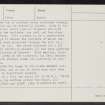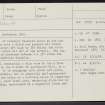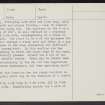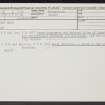Quarry Wood
Henge (Neolithic) - (Bronze Age)
Site Name Quarry Wood
Classification Henge (Neolithic) - (Bronze Age)
Alternative Name(s) Quarrywood Henge
Canmore ID 16231
Site Number NJ16SE 4
NGR NJ 1858 6306
Datum OSGB36 - NGR
Permalink http://canmore.org.uk/site/16231
- Council Moray
- Parish Spynie
- Former Region Grampian
- Former District Moray
- Former County Morayshire
NJ16SE 4 1858 6306.
(NJ 1858 6306) Earthwork (NR).
OS 6" map, Morayshire, 2nd ed., (1969)
A 'Danish Camp' of internal diameter about 44 yards and circular in form with a ditch and parapet all round. The parapet is aobut 4ft high by 3ft thick; the ditch 3ft deep by 3ft broad cut out of the subsoil. The top of the parapet is elevated between 2 and 3ft above the ground in its immediate vicinity.
Name Book 1871; C Maclagan 1875.
At NJ 1858 6306, commanding a wide view to the S from about 360ft OD on the S crest of Quarrywood Hill, is a Class I henge. It is overgrown with scrub and partly planted with conifers, but is generally well-preserved. Constructed at the brink of a S-facing slope it comprises a slightly oval, near level area, measuring 47.0m E-W by 43.0m transversely, surrounded by a segmented ditch cut into the subsoil, averaging 3.0m wide and 0.8m deep, with the excavated earth and stones forming a bank of similar porportions on its outer tip. The entrance in the W on a magnetic bearing of 284 degrees, is well defined by a causeway across the ditch 4.0m wide, corresponding to a break in the bank 3.0m wide. For about 11.0m S of the entrance the ditch has been cut through a stony area and there is a gap of about 2.0m where it has been presumably too difficult to dig and left uncompleted. In this section are two boulders, one seeming to revet the inner edge of the bank, but probably naturally placed. Around the N arc of the ditch are three similar breaks. There may be others less well defined, particularly in the SE, but the vegetation prevents an accurate assessment, and tree uprooting could be the cause.
In the SSW arc of the interior are two rough boulders on edge which may be the remnants of a circle of stone.
(a) is 1.0m high by 1.3m long by 1.0m wide;
(b) is 0.9m high by 1.2m by 0.9m.
Immediately inside the S side of the entrance, the top of another stone protrudes through the soil, but this may be naturally placed. 4.0m to the S of it is a hollow, about 3.0m in diameter and 0.7m deep, containing two boulders, one oval and the other triangular in shape. This appears to be a quarry-hole dug in an attempt to remove the boulders of which one would originally have protruded through the soil in a similar fashion to (c). Two other boulders (e) and (f) are also probably naturally placed;
(e) has been quarried around in anticipation of removal. Much smaller, loose stones occur in parts of the interior, but deep heather makes it uncertain whether these are naturally or art- ificially placed. Immediately outside the henge in the S are several out-crops and boulders, one or two of which have also been quarried around to facilitate removal.
In Elgin Museum is a flat axe mould (NJ16SE 8), which was picked up on the surface within the henge. (Information from I Keillar, Secretary of Elgin Society)
Resurveyed at 1/2500 and 1/500.
Visited by OS (A A) 4 February 1972.
Quarrywood, henge. Air photographs: AAS/97/06/G9/26, AAS/97/06/G10/1-3 and AAS/97/06/CT.
NMRS, MS/712/29.
A contour survey and photographic record of the henge and surrounding clearing was carried out by Headland Archaeology Ltd in February 1997 to assist in the management and interpretation of the monument by Forest Enterprise. A contour interval of 0.2m was used.
The henge is situated on the edge of a steep S-facing slope, and is sub-oval on plan measuring 47m internally and 59m externally from E-W by 42m and 54m respectively transversely. The well-preserved bank and ditch measure between 2 and 3m thick and up to 0.5m high and between 2 and 4m broad and up to 0.8m deep respectively. Both are broken by a causeway 4m wide on the W and the bottom of the ditch is uneven, segments of different depths being separated by low thresholds.
Identifiable features within the interior comprise:
1. two boulders in the SW sector,
2. three boulders situated within hollows (possibly dug during attempts to remove them by quarrying) in the NW sector,
3. a previously-unrecorded length of curving bank (6m long, 1m broad and 0.5m high) situated just N of the centre of the interior.
Sponsor: Historic Scotland.
NMRS, MS/899/28.
NJ 1858 6306 A contour survey of Quarrywood henge was undertaken by Headland Archaeology Ltd to assist in the management and interpretation of the site by Forest Enterprise. The henge is sub-oval E-W and measures 42 x 47m internally and 54 x 59m externally. It was previously covered by trees but now lies in a clearing in the forest.
Sponsor: Historic Scotland 1997
Archaeological Evaluation (23 August 2011 - 31 January 2012)
A series of archaeological works were carried out to investigate Quarrywood Henge, Elgin and to consider the consequence of damage to the site caused by the use of the ground for forestry. The works commenced with a geophysical survey which recorded a series of anomalies. These were interpreted as a circular arrangement of possible negative features which may represent post or stone settings, covering an area which measured approximately 20m in diameter within the henge. A possible penannular feature was also identified, as well as three linear features that may represent marks left by forestry ploughing. In addition a series of signals were found that may represent other negative features which may reflect further activity within the henge, such as burials, burning or occupation areas. Three targeted areas within the monument were hand excavated to recover information relating to the monument's date and form as well as examining the nature of any damage from visitor erosion and forestry operations. These showed the construction of the bank and ditch to have been possibly consisted of two phases, with the spoil of the ditch forming the ditch. The trench in the central area of the henge did not contain any archaeology. Several pieces of flint debitage were recovered from under the northern bank of the henge. All the targeted areas showed root penetration down to and into subsoil, causing varying degrees of disturbance to the underlying sediments. In addition the walkers path was shown to have caused erosion along its length through the monument, with the loss of material up to 200mm in depth.
Information from Oasis (rathmell1-111520) 21 August 2013
Geophysical Survey (27 October 2011)
NJ 1858 6306 A flux-gate gradiometer survey was undertaken on 27 October 2011 in advance of evaluation work. This formed part of restoration works being carried out in response to footpath erosion. The survey area of 0.34ha covered the henge earthworks and associated forest clearing, using a sampling density of 0.25 x 1m. A concentration of globular negative anomalies and areas of pronounced magnetic disturbance were recorded in the centre-north interior of the site. These formed a generally circular arrangement and were interpreted as possible pits or post settings. Equidistant parallel linear anomalies, which crossed the site NW–SE, were interpreted as remains of forestry ploughing.
Archive: RCAHMS (intended)
Funder: Rathmell Archaeology Ltd and Forestry Commission Scotland
OJT Surveys, 2011


















